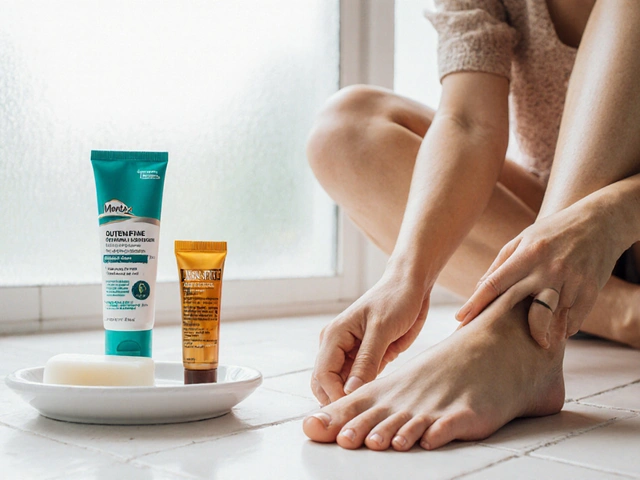You can train hard, sleep well, and still leave gains on the table if your protein is off. That’s the gap a good scoop of whey protein fills-fast-digesting, rich in leucine, and easy to hit targets without cooking another chicken breast. It won’t do the work for you. It will make the work count-more muscle from each session, better recovery, and steadier fat loss when calories are tight.
Here’s what you’ll get: the why (science, clear and plain), the how (doses and timing you can start today), and the what (which type to buy in 2025, and how to avoid the duds). Expect straight answers and steps you can follow without a calculator in your gym bag.
TL;DR - Key takeaways
- Why it works: Whey is high in leucine and digests fast, which spikes muscle protein synthesis after training more than slower proteins (JISSN position stand, 2017; Tang et al., 2009).
- How much: Aim for 1.6-2.2 g of protein per kg body weight per day (Morton et al., BJSM, 2018). Per shake: 20-30 g covers most adults; bigger athletes may need 35-40 g.
- When: Within two hours after lifting, or any time a meal will be late. Spread protein across 3-5 meals with 2-3 g leucine each time.
- What to buy in 2025 (UK/IE): Look for Informed-Sport tested whey, minimal ingredients, and 20-25 g protein per 30 g serving. Use isolate if you’re lactose sensitive.
- What it won’t do: It won’t outrun poor training, bad sleep, or a calorie surplus when you’re trying to cut.
Why whey helps you build muscle, lose fat, and recover faster
Whey is fast. That matters. After you train, your muscles are more sensitive to amino acids for a few hours. Whey hits the bloodstream quickly and delivers a big dose of leucine, the amino acid that flips the switch on muscle protein synthesis (MPS). Studies comparing whey to slower proteins show whey triggers a stronger, earlier MPS response (Tang et al., Journal of Applied Physiology, 2009; Tipton & Phillips, 2013 review).
Leucine content is the cheat code. About 2-3 g leucine per meal is the “threshold” that maximally stimulates MPS in most adults (Phillips, Appl Physiol Nutr Metab, 2014). A 25 g serving of whey usually hits that. Plant blends can get there, but you often need a bigger serving or added leucine.
Fat loss isn’t just calories. Higher protein keeps you fuller, protects muscle in a deficit, and boosts diet adherence. Whey scores well on satiety and thermic effect (Westerterp-Plantenga et al., 2009; Hall et al., 2015 energy balance work). In simple terms: you’re less snacky, and you keep the muscle you’ve fought for while the fat comes off.
Recovery is where people feel it first. Less next-day soreness, steadier performance on back-to-back sessions, and fewer “I’m flat” workouts. A 2013 meta-analysis in the Journal of the International Society of Sports Nutrition showed protein supplementation around training improved strength and fat-free mass, especially when total daily protein before the study was low. Morton's 2018 umbrella analysis nailed the daily target: 1.6 g/kg/day hits most of the hypertrophy curve; going up to ~2.2 g/kg/day may help some lifters at the margins.
Types, in plain English:
- Concentrate (WPC 70-80%): Tasty, cost-effective, has a bit more lactose and fat. Fine for most people.
- Isolate (WPI 85-90%): Leaner, lower lactose. Best if you’re sensitive to dairy or want fewer calories per scoop.
- Hydrolysate (WPH): Pre-digested, very fast, pricier, often bitter. Useful if you’re chasing rapid absorption or have GI issues with other types, but not required for gains.
2025 buying note (UK/IE): With sports supplement mislabeling still a risk, look for Informed-Sport or Informed-Choice certification. That logo means a batch-tested product for banned substances-handy if you compete or just want peace of mind. Also check the panel: you want 20-25 g protein per 30 g scoop, 2-3 g leucine per serving, and a short ingredient list.
Step-by-step: how to use whey to hit your specific goal
Think in three layers: daily target, per-meal target, and timing.
- Set your daily protein target. Use 1.6-2.2 g/kg/day (0.7-1.0 g/lb). If you’re cutting, older (50+), or very active, bias toward the higher end. Example: 80 kg person = 130-175 g/day.
- Split that across 3-5 meals. Shoot for ~0.3 g/kg per meal (24 g for an 80 kg person) to hit the leucine threshold. Bigger folks may need 0.4 g/kg at meals.
- Use whey to fill the gaps. If breakfast is low-protein or you train at lunch, a 25-30 g shake closes the gap quickly.
- Time it smartly around training.
- After lifting: 20-40 g within two hours works well (JISSN timing paper, 2017). If you trained fasted, make it sooner.
- Before training: If your last meal was 4+ hours ago, a 20 g shake 30-60 minutes pre-workout helps.
- Rest days: Keep daily protein the same; timing is flexible.
- Pick the right type.
- Concentrate if you digest dairy fine and want best value.
- Isolate if lactose bothers you or every calorie counts.
- Hydrolysate only if you’ve tried the others and had issues-or you’re chasing very fast absorption for a specific reason.
- Dial in the serving size.
- 60-80 kg: 20-30 g per shake.
- 80-100 kg: 25-35 g per shake.
- 100 kg+: 30-40 g per shake.
- Mix and match with real food. Whey isn’t a meal by itself. Pair it with fruit and oats post-workout for carbs, or blend with Greek yogurt if you want it thicker.
- Creatine plays nice. Add 3-5 g creatine monohydrate to your post-workout whey. No need to load. Safe and effective for strength and size (Kreider et al., 2017 review).
- Track and adjust. If strength stalls or you’re hungry all the time on a cut, bump daily protein by 10-20 g or add a small meal. If the scale won’t move up on a bulk, you likely need more carbs and total calories, not only more whey.
Simple rules of thumb:
- If you missed a meal: have a shake.
- If you trained: have a shake within two hours.
- If your day ends under target: add a shake with milk to nudge calories up, or with water if you’re cutting.

Real-world examples, scenarios, and what to expect
Different goals, same tool-used a bit differently.
1) Busy lifter on a cut (75 kg)
Target: 120-150 g/day. Breakfast is light? Make a 25 g whey shake and an apple. Train at 6 pm? Post-workout, another 25-30 g with a banana. Add chicken or tofu at dinner and you’ve hit your numbers without feeling starved. Expect steadier energy and better soreness control as calories drop.
2) Skinny-hardgainer trying to add size (80 kg)
Target: 140-175 g/day, plus a calorie surplus. Blend 30 g whey with oats, frozen banana, peanut butter, and milk for a 600-800 kcal shake you can drink even when you’re not hungry. Post-workout, repeat. Expect 0.25-0.5 kg per week when you pair this with progressive training and more carbs.
3) Endurance athlete (10k runner, 65 kg)
Target: 105-140 g/day. After long runs or hard intervals, 20-25 g whey plus 40-60 g carbs helps muscle repair and glycogen refill. Expect fewer dead-leg days and better back-to-back training tolerance.
4) 50+ lifter chasing strength without aches (82 kg)
Target: 160-180 g/day. Age-related anabolic resistance means you may need 30-40 g protein per meal to hit leucine thresholds. 30 g whey post-training is a simple anchor. Expect steadier gains and less soreness between sessions.
What improvements feel like in two weeks: less DOMS, better bar speed in warm-ups, and more consistent reps at the end of sets. Body weight may hold steady on a cut while waist tightens. That’s the point-muscle retention.
| Type | Protein per 30 g | Lactose | Typical UK price (2025) | Best for | Watch-outs |
|---|---|---|---|---|---|
| Whey Concentrate (WPC) | 22-24 g | Moderate | £12-£16 per kg | Most lifters; best value | Can bloat if lactose-sensitive |
| Whey Isolate (WPI) | 25-27 g | Low | £18-£26 per kg | Lactose-sensitive; cutting phases | Costs more, taste sometimes thinner |
| Hydrolyzed Whey (WPH) | 24-26 g | Very low | £28-£40 per kg | Fastest absorption; sensitive stomachs | Pricey; can taste bitter |
Cheat-sheets, checklists, and a quick decision tree
Buying checklist (2025):
- Certification: Informed-Sport (UK/IE) if you compete or want extra assurance.
- Label: 20-25 g protein per 30 g scoop; leucine 2-3 g per serving (often listed).
- Ingredients: Short list. Whey, cocoa/vanilla, sweetener. Avoid heavy “gainer” blends unless bulking.
- Sweetener: Sucralose is common; if you prefer natural, stevia works but can taste sharper. Unflavoured is safest for recipes.
- Allergens: If lactose-sensitive, choose isolate. Severe dairy allergy? Use a plant blend instead (see FAQ).
- Batch code and best-before date: Fresh product mixes better and tastes better.
Mixing cheat-sheet:
- Cutting: water + ice = lowest calories, clean taste.
- Maintenance: semi-skimmed milk adds ~10 g protein and creamier texture.
- Bulking: blend with oats, banana, peanut butter, and milk for a 600-800 kcal shake.
- Pre-bed: you can use whey, but casein or Greek yogurt is slower if you want a longer drip of amino acids.
Quick decision tree:
- Do you digest dairy fine? → Yes → Choose Concentrate for value. → No → Choose Isolate.
- Are you on a tight budget? → Yes → Concentrate. → No → Isolate if calories or lactose matter.
- Do you need ultra-fast absorption or have GI issues with others? → Try Hydrolysate.
- Do you compete in tested sports? → Look for Informed-Sport on the tub.
Dosing cheat-sheet by body weight:
- 60-70 kg: daily protein 95-155 g; shakes: 20-25 g.
- 70-85 kg: daily protein 110-185 g; shakes: 25-30 g.
- 85-100 kg: daily protein 135-220 g; shakes: 30-35 g.
- 100 kg+: daily protein 160-240 g; shakes: 35-40 g.
Kitchen tips:
- Pancakes: mix whey into batter after wet ingredients to avoid rubbery texture.
- Overnight oats: stir whey in the morning to keep it smooth.
- Hot drinks: temper whey with cool water first, then add to coffee to prevent clumps.
- Shaker hygiene: rinse right after drinking. Dried whey is why shakers smell like a crime scene.
Mini-FAQ: straight answers to common worries
Is whey safe for kidneys?
In healthy people, high-protein diets have not been shown to harm kidney function (Poortmans & Dellalieux, 2000; Devries & Phillips, 2018 review). If you have existing kidney disease, follow your clinician’s protein guidance.
What if I’m lactose intolerant?
Most isolates are very low in lactose and are well tolerated. You can also use a lactase tablet with concentrate. If dairy is a no-go, use a plant blend (pea + rice) at a slightly higher dose to match leucine.
Do I need a shake immediately after my last rep?
The “anabolic window” is wider than we once thought. A solid protein dose within two hours of training is fine, and even longer works if you had a protein-rich meal beforehand (JISSN timing position, 2017).
Will whey make me gain fat?
Calories make you gain fat. Whey is just protein in a scoop. It can help you stay full and stick to your numbers. If the scale climbs too fast, check your total calories, not just the shake.
Can teenagers use whey?
Yes, as a food protein source-assuming no dairy allergy. Focus first on regular meals. A shake is a practical add-on for sport or growth phases. Parents: check labels and keep it simple.
Is hydrolyzed whey worth it?
For most, no. It digests slightly faster and can help if you get GI issues with other forms, but it’s often not better for muscle gain than isolate or concentrate when daily protein is matched.
Does whey cause acne?
Some people report flare-ups, possibly from dairy bioactives. Evidence is mixed. Try switching to isolate, lowering dose, or trial a plant protein for 4 weeks and see if skin calms down.
How many shakes per day is too many?
There’s no set cap. Two shakes per day is common. Try to get at least half your protein from whole foods for micronutrients and fiber.
Best time for a shake on rest days?
Any time you’d normally have a lower-protein meal. Your daily total matters more than timing on rest days.
Should I combine whey with carbs?
Post-workout carbs help refill glycogen and can aid recovery, especially if you train often. Protein alone still stimulates MPS; add carbs based on your calorie goal.

Next steps and troubleshooting for different situations
If you’re cutting and feel constantly hungry: Move one whey serving earlier in the day, add 200-300 ml water and ice to make it more filling, and pair it with a high-fiber fruit. Bump daily protein by 10-20 g and swap one low-protein snack for Greek yogurt or cottage cheese.
If you’re bulking but the scale won’t budge: Add a second blended shake with oats or honey, and increase carbs at two meals by a fist-sized portion. Keep protein steady once you’re at 1.6-2.2 g/kg; more protein won’t replace the need for more calories.
If your stomach feels off: Try smaller, more frequent servings (e.g., 15-20 g twice instead of 30-40 g once). Switch from concentrate to isolate. Check the sweetener-some sugar alcohols bloat people. Sip slowly instead of chugging.
If you’re on a tight budget: Buy 2.5-5 kg bags during sales, compare cost per 100 g of protein (not per tub), and stick to concentrate. Unflavoured options are often cheaper and you can add cocoa and instant coffee at home.
If you compete in tested sport: Use Informed-Sport certified whey and keep photos of batch numbers. This covers you if you ever need to prove due diligence.
If you train early: A 20-25 g shake pre-workout if you wake up flat, then a normal breakfast after. If coffee is your thing, mix the whey with cool water first, then add to warm coffee to avoid clumps.
If late-night cravings hit: Make a thick shake with milk, ice, cinnamon, and a spoon of nut butter. If you want slower digestion, swap to casein or add Greek yogurt, but whey still works if your daily total is on point.
Quick 7-day plan to lock the habit:
- Day 1: Buy a tested whey and a shaker. Pre-log two shakes in your food tracker.
- Day 2: Hit your protein target with at least four feedings.
- Day 3: Train and have a post-workout shake within two hours.
- Day 4: Try one new recipe (oats, smoothie bowl, or coffee shake).
- Day 5: Weigh yourself in the morning; adjust carbs based on goal.
- Day 6: Swap to isolate if you had GI issues.
- Day 7: Review your week: Did you hit protein 5/7 days? Keep the routine.
Bottom line for 2025: The blend of speed, leucine punch, and convenience is why whey keeps winning. Get a trustworthy tub, hit your daily target, and place a shake when it solves a real problem-missed meal, post-lift window, or a day that went sideways. That’s how you unlock the gains you’re already earning in the gym.







Elizabeth Grant
September 1, 2025 AT 09:00Whey isn't magic-it's just the most convenient way to hit your leucine threshold without chewing through a cow. I've seen people burn out on meal prep and then quit lifting because they thought they needed six chicken breasts a day. A shake? Easy. Consistent? Yes. That's the real win.
Merlin Maria
September 2, 2025 AT 06:17The notion that whey is a 'cheat code' is deeply misleading. Protein synthesis is not a binary switch-it's a dynamic, hormetic process influenced by circadian rhythm, insulin sensitivity, and gut microbiota. To reduce it to 'leucine spikes' is reductionist nonsense dressed in science-speak.
Fiona Hoxhaj
September 2, 2025 AT 11:53How quaint. We've elevated protein supplementation to the level of a sacrament while ignoring the deeper epistemological crisis of modern fitness culture-where convenience is mistaken for wisdom, and biochemistry is weaponized to sell powder in plastic tubs. The real gain? Not muscle. It's the illusion of control.
Nagamani Thaviti
September 3, 2025 AT 06:19LaMaya Edmonds
September 4, 2025 AT 01:32Oh sweetie, you're telling me to 'use whey to fill gaps' like it's a Band-Aid for a broken diet. Honey, if your entire protein strategy hinges on a shaker bottle, you're not training-you're performing. But hey, at least you're not drinking meal replacement shakes with 'superfood blends' and spirulina. Progress?
Michelle Machisa
September 5, 2025 AT 17:56My mom started using whey at 62 after her hip surgery. She went from barely walking to hiking again. No magic. Just consistent protein. If you’re over 50 and still thinking 'natural foods only'-you’re not being disciplined, you’re being stubborn. Whey isn’t the enemy. Laziness is.
Monika Wasylewska
September 5, 2025 AT 20:54neville grimshaw
September 6, 2025 AT 06:38Look, I’ve been lifting since the 90s. Back then we ate eggs, drank milk, and called it a day. Now we’ve got PhDs writing essays on leucine thresholds and Informed-Sport logos like it’s some kind of holy seal. It’s whey. It’s protein. It’s not a religion. Also, why is every tub now '2025 edition'? Are we in a sci-fi novel?
See Lo
September 6, 2025 AT 21:27Whey is a gateway drug to corporate fitness indoctrination. The Informed-Sport certification? A marketing ploy. The FDA doesn't regulate supplements properly. You're literally gambling with your hormones every time you open a tub. And don't get me started on the sucralose. It's not 'safe'-it's just not proven to kill you yet.
Chris Long
September 7, 2025 AT 05:47Whey? That's what they feed the sheeple in America. Real men eat steak. Real men cook. Real men don't drink chalky powder from a plastic bottle because they're too lazy to roast a chicken. This is why the West is falling apart-because we've outsourced our biology to a supplement aisle.
Liv Loverso
September 8, 2025 AT 15:40What’s being sold here isn’t protein-it’s the myth of optimization. We’ve turned the body into a machine that needs firmware updates. But muscles aren’t code. They’re flesh. They remember hunger. They respond to rhythm. To reduce them to leucine thresholds and timing windows is to misunderstand life itself. The real gain? Not in the shake. In the silence between reps.
Steve Davis
September 10, 2025 AT 09:04Bro I’ve been doing this for 15 years and I’ve never once used whey. I just eat. And guess what? I’m bigger than half these guys. Why are we all so obsessed with this? Is it because we’re afraid of real food? Or because we want to feel like we’re doing something 'scientific'? I don’t need a 25g scoop to feel like a man. I need to look in the mirror and know I didn’t cheat.
Attila Abraham
September 12, 2025 AT 02:10Just drink the damn shake and stop overthinking it. You're not writing a thesis-you're trying to get stronger. If you're worried about lactose, use isolate. If you're broke, buy concentrate. If you're lazy? Then yeah, you're probably gonna fail. But the shake? It's not the problem. Your excuses are.
Shawn Jason
September 12, 2025 AT 22:38It’s fascinating how we treat protein like a currency. You 'spend' leucine, you 'earn' muscle. But what if the body isn’t an accountant? What if it’s more like a gardener-slow, patient, responding to seasons, not spreadsheets? Maybe the real insight isn’t in the timing… but in the trust.
Kamal Virk
September 13, 2025 AT 13:38The science is clear. Protein timing matters less than total daily intake. The emphasis on post-workout windows is overblown. This article confuses correlation with causation. Many who use whey are already disciplined eaters. The supplement is a symptom-not the cause-of their success.
Jackie Burton
September 14, 2025 AT 15:17Did you know whey is often processed with hexane? And that the 'Informed-Sport' certification costs companies $5,000 per batch-they don't test every single tub. Also, most 'natural flavors' are synthetic. And the sweeteners? They rewire your dopamine response. This isn't nutrition. It's behavioral engineering disguised as fitness.
Philip Crider
September 15, 2025 AT 16:00Bro I just use whey with banana and peanut butter and call it a day 😌✨ I don’t care about leucine or ISO or whatever. I just want to lift heavy and not feel like a zombie. Also my dog licks my shaker now. He knows good stuff when he sees it 🐶💪
Diana Sabillon
September 16, 2025 AT 04:57I used to think whey was unnecessary. Then I had a baby, went back to work, and had 45 minutes to eat between shifts. A shake saved my strength. It’s not about perfection. It’s about showing up. And sometimes, that means drinking powder instead of cooking.
Ronald Thibodeau
September 17, 2025 AT 17:55Why are we still talking about this? Everyone knows whey works. The real question is why you’re still reading this instead of going to the gym. Also, if you’re spending $40 on hydrolysate, you’re not training-you’re shopping.
angie leblanc
September 17, 2025 AT 19:22